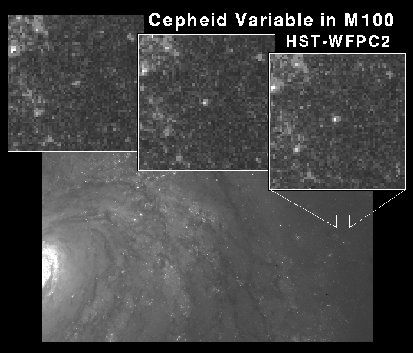Astronomy Picture of the Day
Discover the cosmos! Each day we feature a different image or photograph
of our fascinating universe, along with a brief explanation written by a
professional astronomer.
January 10, 1996

The Cepheids of M100
Credit:
NASA,
HST,
W. Freedman (CIW),
R. Kennicutt (U. Arizona),
J. Mould (ANU)
Explanation:
Can this blinking star tell us how fast the universe is expanding? Many
astronomers also believe it may also tell us the age of the universe! The
photographed
"Cepheid
variable" star in
M100 brightens and dims over the
course of days as its atmosphere expands and contracts. A longer
blinking cycle
means an intrinsically brighter star.
Cepheids variable
stars are therefore used as
distance
indicators. By noting exactly how long
the blinking period is and exactly how bright the star appears to be, one
can tell the distance to the star and hence the star's parent galaxy. This
distance can then be used to match-up easily measured recessional velocity
("redshift") with distance. Once this
"Hubble
relation" is determined for
M100, it should be the same for all galaxies -
and hence tell us how fast the
universe is expanding. The exact magnitude
of this calibration is under dispute and so a real live debate involving
the value of
Hubble's
constant titled
"The Scale of the Universe" will
occur in April 1996 in Washington, DC.
Tomorrow's picture: Lasers in Eta Carinae
| Archive
| Index
| Glossary
| Education
| About APOD |



Authors & editors:
Robert Nemiroff
(GMU) &
Jerry
Bonnell (USRA).
NASA Technical Rep.:
Sherri
Calvo.
Specific rights apply.
A service of:
LHEA
at
NASA/
GSFC



